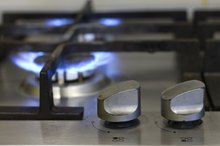How to Dispose of Xylene & Toluene in a Laboratory
Technicians commonly use xylene and toluene in a laboratory setting. Hematology labs that test blood rely on both of these chemicals as solvents, while hospital laboratories can use either chemical in preparing tissue specimens and rinsing stains. According to the Occupational and Health Safety Administration (OSHA), exposure to xylene and toluene can result in severe and chronic health conditions such as abdominal pain, nausea, bronchitis and bronchial pneumonia, among others. Properly disposing of these chemicals ensures laboratory and environmental safety 1.
Dispose of Xylene
Turn off any sources of ignition or any device that can spark, including hot plates and Bunsen burners. OSHA classifies both xylene and xylene vapor as severe fire hazards. Turn on any ventilation devices, such as overhead laboratory fans or fume hoods, to reduce the risk of xylene vapor combustion (you cannot dispose of xylene vapor this way).
Side Effects of Inhaling Bleach
Learn More
Put on safety glasses and safety gloves. Xylene and xylene vapor can seep into the skin, eyes, mouth and lungs. Be careful not to inhale any of the xylene vapor. OSHA recommends that those not wearing protective equipment should leave the room.
Clean up any spills with sand or an absorbent material that does not combust, such as silica gel. Spray the air with water to reduce the risk of fire.
Side Effects of Formaldehyde Exposure
Learn More
Place xylene in a nonchlorinated waste container for disposal. Store it outdoors or in an unoccupied building in a fire-proof storage unit.
Call a chemical waste disposal service to remove the container containing xylene. According to Practice Green Health, you must have xylene removed within three days of accumulating more than 55 gallons of this hazardous waste.
- Turn off any sources of ignition or any device that can spark, including hot plates and Bunsen burners.
- Turn on any ventilation devices, such as overhead laboratory fans or fume hoods, to reduce the risk of xylene vapor combustion (you cannot dispose of xylene vapor this way).
Dispose of Toluene
Turn off any sources of ignition or any device that can spark, including hot plates and Bunsen burners. Toluene and toluene vapor are highly flammable.
Put on safety glasses and safety gloves. Liquid toluene can chemically burn the skin, causing redness, and toluene vapor can damage the eyes. Be careful not to inhale any of the toluene vapor.
Clean up any toluene spills by covering them with sand, clay, dirt or an organic commercial product. You can allow small spills to evaporate.
Place toluene in a nonchlorinated waste container for disposal. Store this container in an unoccupied building or outdoors.
Call a chemical waste disposal service to remove the container containing toluene. According to Practice Green Health, you must have toluene removed within three days of accumulating more than 55 gallons of this hazardous waste.
Tips
Both Toluene and Xylene are water insolvable. In the event of a fire, use carbon dioxide, foam or dry chemical extinguishers.
Warnings
Immediately rinse the eyes and skin if exposed to Toluene or Xylene. Flush the eyes with water for fifteen minutes.
- Turn off any sources of ignition or any device that can spark, including hot plates and Bunsen burners.
- According to Practice Green Health, you must have toluene removed within three days of accumulating more than 55 gallons of this hazardous waste.
Related Articles
References
Tips
- Both Toluene and Xylene are water insolvable. In the event of a fire, use carbon dioxide, foam or dry chemical extinguishers.
Warnings
- Immediately rinse the eyes and skin if exposed to Toluene or Xylene. Flush the eyes with water for fifteen minutes.
Writer Bio
Since 2005, James Rutter has worked as a freelance journalist for print and Internet publications, including the “News of Delaware County,” “Main Line Times” and Broad Street Review. As a former chemist, college professor and competitive weightlifter, he writes about science, education and exercise. Rutter earned a B.A. in philosophy and biology from Albright College and studied philosophy and cognitive science at Temple University.








